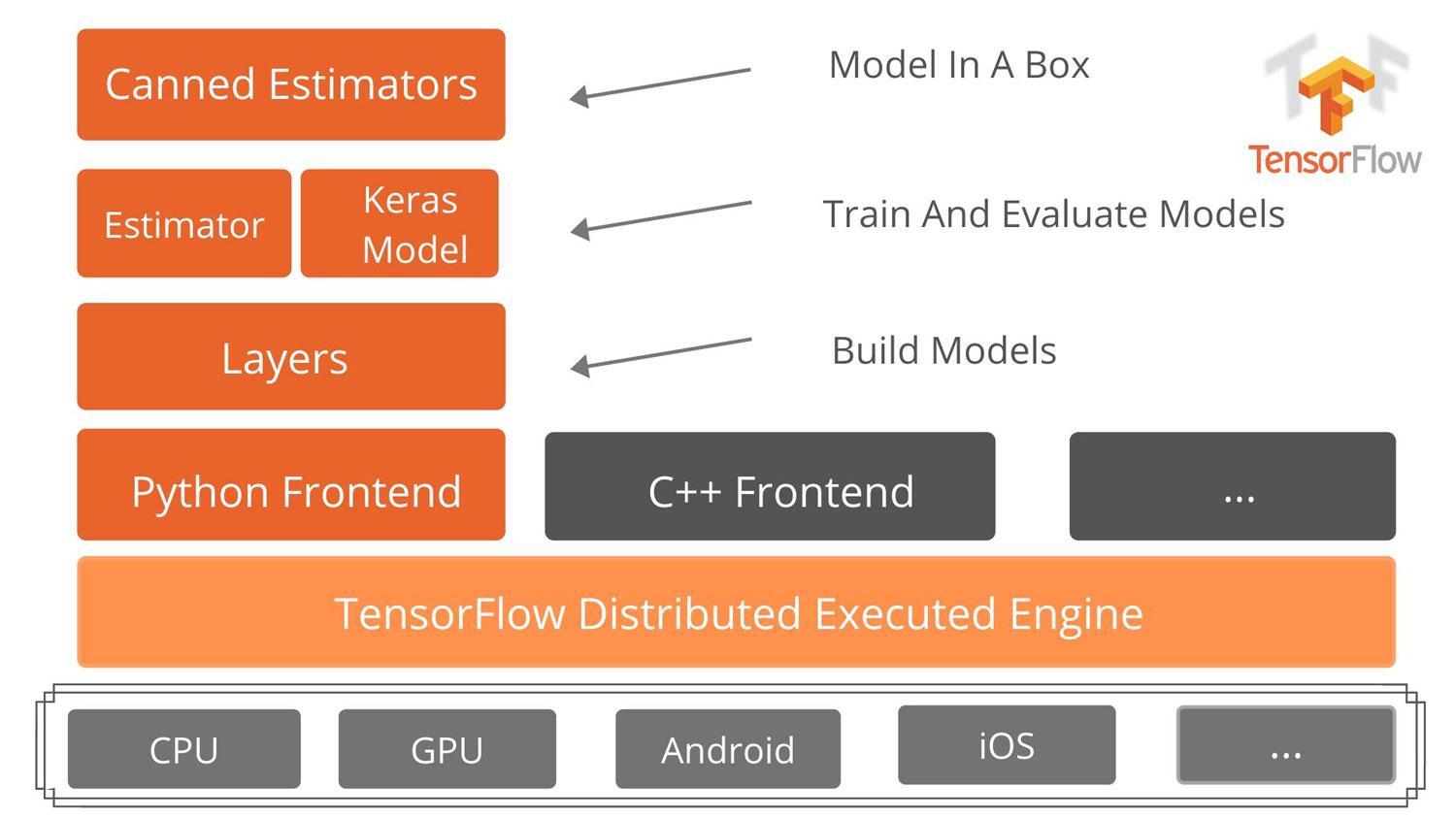TensorFlow

Data Analyst
Experienced data analyst working with data visualization, cloud computing and ETL solutions.
February 8, 2020
Machine learning and the branches associated with it
With the development in Machine learning technology performance of onerous tasks has become easier and effortless. This has thoroughly impacted the growth of any organization. Through Machine learning; electronic devices can carry out their operations using step by step procedure known as algorithms. Algorithms teach computers to undertake any complex task and perform them successfully. Machine Learning has several practical applications that give immediate business results. One such advanced technique of machine learning is deep learning. Deep learning uses algorithms termed as Neural Networks. In Deep learning, the computer program follows a learning approach from the data input given to it and then deploys this learning to arrive at new observation.
A few examples of deep learning are speech recognition, biometric identification, handwriting recognition, etc. Through deep learning, these electronic models can achieve accurate results which may sometimes exceed the human-level performance.
Emergence of TensorFlow
A few years ago, deep learning started to become successful when compared to all other machine learning algorithms and branches by accomplishing the ultimate goal. Google began the use of these deep learning neural networks to strengthen its core services:
• Gmail
• Photo
• Google Search Engine
They formulated a framework termed as TensorFlow which helped the coders and developers to work together on an AI model.
What is TensorFlow?
Tensor Flow is a machine learning framework or an open-source library that allows a developer to build machine models and is used for mathematical computations. The python programming language is used in TensorFlow, to provide a suitable front end interface for building applications within the framework. The creation of machine learning models becomes easier by using this numerical computation. The machine learning models are designed for desktop, mobile, web, and cloud. This open-source library was created by Google and act as a platform for deep learning applications. TensorFlow accepts data in an array with more than one dimension which is known as multidimensional arrays. These multidimensional arrays are well designed and useful in handling the bulk amount of data.
This open-source library was most importantly designed for developers, students, researchers or scientists where they can share their findings or indagation conducted by them. Developers with a basic background in TensorFlow can use this tool for training, data sets, etc. TensorFlow is not just confined to a mathematical library. It also works extremely well with both CPUs and GPUs.
Working of TensorFlow
TensorFlow functions by creating a graph. The graph has a set of nodes where these lines intersect. The nodes are plotted in the graph after taking the data in a specific format and thereby giving the desired result. The multidimensional arrays on the edges of the TensorFlow graphs are known as Tensors The nodes of the TensorFlow graph depicts some mathematical function. Even the edges in the graph also represent the data that is being passed through a particular node. Therefore TensorFlows is also known as Flow Graph Library. The nodes and tensors of the TensorFlow graphs are treated as Python objects and the TensorFlow applications are known as Python Applications. In TensorFlow, Python is a high-level programming language that provides quality ideas to hook the nodes together.
This graph deals with a few types of data and they are Categorical Data and Continuous Data. Both these type of data is important while carrying out machine learning tasks. For example; if you desire to anticipate the remuneration of a person given the age and nationality, then age and nationality represent the Categorical and Continuous Data. TensorFlow applications can be executed on any convenient target. This may include iOS and Android devices, a local machine, CPU and GPU's. TensorFlow 2.0 is the latest application released in 2019 which is more performant and relatively easier to work with.

Importance of TensorFlow
TensorFlow's are an open-source mathematical library used for training neural networks and indicating the decoded patterns as well as correlation. They also resemble human learning and reasoning. The importance of TensorFlows has been stated below:-
• Elimination of Errors
During the initial stage, there are possibilities for experiencing trouble during neural machine learning. Especially while using unsuitable open-source software it may be difficult to get the desired output without any errors. But with the implementation of this powerful and effective tool, the repetitively occurring errors if any; can be reduced or eliminated to a great extent. TensorFlow helps in reducing any inaccuracy or miscalculation from 55% to 85%.
• Helps in the computation of ideal neural network
In the last few years, developers and professionals were facing a tough time to determine the best network and put an end to the problem. But with the inception of TensorFlow, the right neural network can be identified earlier before any architectural search issue arises. This tool can be the right solution to your existing problem. TensorFlow will never cause a burden to your finances.
• Quicker Iteration process
Coders using TensorFlow can repeat a set of instructions for a specified number of times until a condition is met quickly and professionally.
• Training of models at a faster pace
The machine learning models can be trained quickly using the TensorFlow application. It thereby helps to achieve incredible results.
Components of TensorFlow
The two main components of TensorFlow are
• Tensor
• Graphs
Tensor
The core framework of a TensorFlow is known as Tensor. Tensor is a vector or matrix of n-dimensions that depicts different types of data. The values plotted in the tensor holds similar data types with a recognizable shape. The shape of a tensor depends on the number of elements present in each dimension. The three main notations used to describe tensor dimensionality may include rank, shape, and dimension number. TensorFlow offers methods to design tensor functions and compute the derivatives automatically.
Graphs
Graphs are a notional way of defining computations as a directed graph. A directed graph is a graph that consists of nodes (vertices) and edges. The graphs may vary in different shapes and size depending on the data structure. The graphs are useful in resolving a vast number of problems and are a great solution provider. The nodes in the TensorFlow graphs represent operations, variables, or placeholders. According to a specific set of rules, Operations are created. Those rules are called Ops. On the other hand, Variables represent a persistent state that can be controlled by the running Ops. The edges of the directed Graph depicts to data which flows through the different operations. TensorBoard is the visualizing tool that helps one to visualize the graphs and plot the nodes if required.
Installation of TensorFlow
If you're already using a Python SciPy environment, then the installation of TensorFlow is relatively easy. TensorFlow works well with Python3.5-3.7. For windows user TensorFlow offers two versions:
• TensorFlow with CPU support - this version is followed when the machine is not executed on NVIDIA GPU.
• TensorFlow with GPU support - For effortless and speedy computation, you can use this version of TensorFlow. This version is applied when at the need for potent computational capacity.
For a macOS User:
• Install Anaconda version 4.3.1
• Install TensorFlow by creating a .yml file
• Launch Jupyter Notebook
For a Windows User:
• Install Anaconda version 4.3.1
• Install dependencies by creating a .yml file
• Add TensorFlow using pip
• Launch Jupyter Notebook
What makes TensorFlow so popular?
TensorFlow is regarded as the best open-source library as it is constructed to be accessible for everyone. TensorFlow library includes different application programming software (API) to built deep learning architecture. The directed graph used in TensorFlow helps the developer to visualize the neural network in a better manner and helps to remove the errors from the program.
Benefits of TensorFlow
• In machine learning, this open-source library (TensorFlow) mainly deals with ideas or abstractions. Instead of paying attention to the basic details of implementing algorithms, the developer can focus on the complete logic of the application. TensorFlow's eager execution mode (where operations are evaluated instantly) helps to alter the operation of each graph separately and transparently.
• With the use of High-performance APIs, the developers and programmers can have complete control over their large scale machine learning models. These production models can be easily trained and used from anywhere.
TensorFlow is a vast open source library software, which can be used for various numerical and graphical computations of data in designing deep learning neural networks and is the most widely used software tool for various applications such as Google Photos, Google Search, and Google Translate, etc. With the development in machine learning and artificial intelligence (AI), TensorFlow is the appropriate tool that helps to accomplish the goals.













